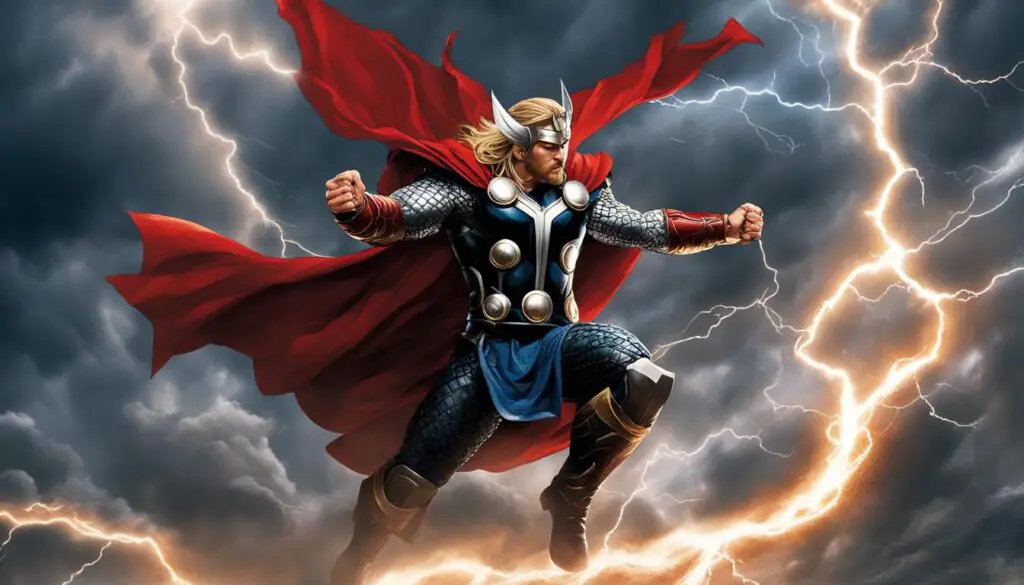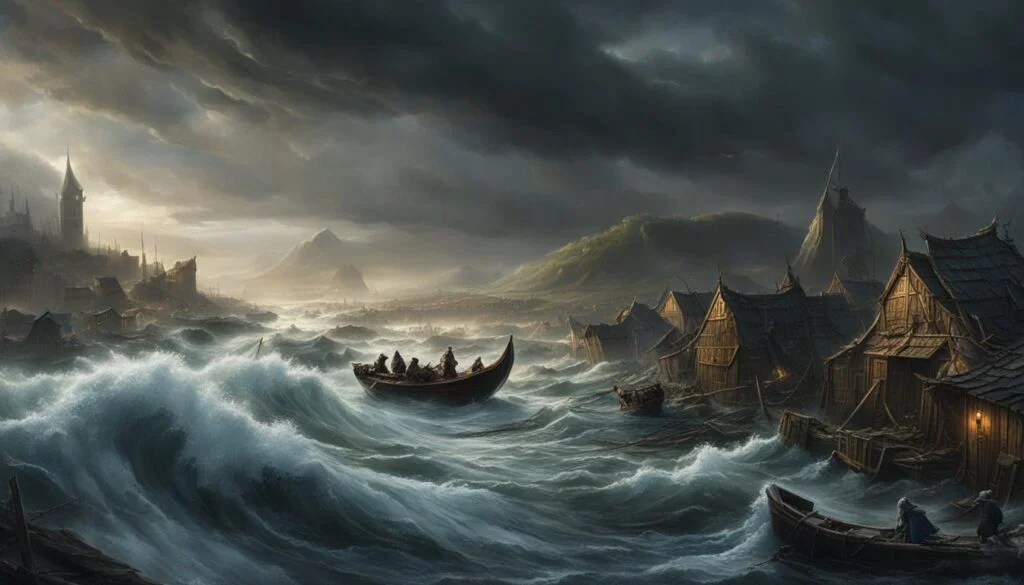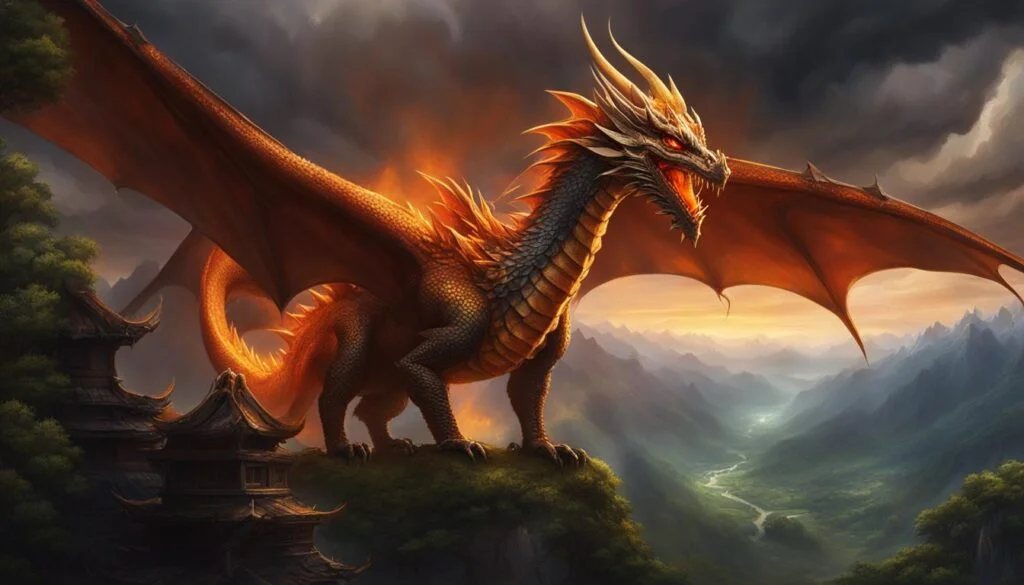In Norse mythology, Thor is known for his incredible strength, bravery, and control over thunder, lightning, and storms. But can the god of thunder actually fly? Let’s delve into the mythology to uncover the truth behind Thor’s abilities.
Key Takeaways:
- Thor is revered for his immense physical strength and unwavering bravery.
- He has the power to control thunder, lightning, and storms.
- In Norse mythology, Thor’s ability to fly is attributed to his chariot, not his hammer.
- Thor’s family and lineage play significant roles in his mythological journey.
- Marvel’s adaptation of Thor differs from the original Norse myths in terms of his powers and backstory.
The Depiction of Thor in Marvel vs. Norse Mythology
When it comes to the portrayal of Thor, Marvel has taken inspiration from the rich tapestry of Norse mythology while also adding their own unique twist. While the comics and movies retain certain elements of the original myths, there are notable differences in the character’s abilities, powers, and backstory. Marvel has successfully merged the ancient tales of Norse mythology with the modern superhero world.
Marvel’s Thor possesses a wide range of impressive abilities and powers that captivate both comic book enthusiasts and moviegoers alike. As the god of thunder, Thor harnesses the power of lightning with his iconic weapon, the mighty hammer Mjolnir. With Mjolnir in hand, Thor can summon lightning bolts and unleash devastating storms, showcasing his dominion over thunder and natural forces.
Moreover, Marvel’s Thor is depicted as an incredibly strong and formidable warrior, able to go toe-to-toe with some of the most powerful beings in the universe. His physical strength, combined with his fighting skills, make him a formidable force on the battlefield.
In contrast, Norse mythology portrays Thor as a god known primarily for his strength and bravery. While he still possesses incredible physical prowess and courage in both Marvel and Norse mythology, the emphasis on his thunder-related abilities is more pronounced in the Marvel adaptations.
Marvel’s depiction of Thor has undoubtedly added a new layer of fascination to the character, weaving together elements of ancient Norse myths with modern superhero lore. The amalgamation of these two worlds has brought Thor into the hearts and minds of countless fans around the globe.
Thor’s Strength and Bravery
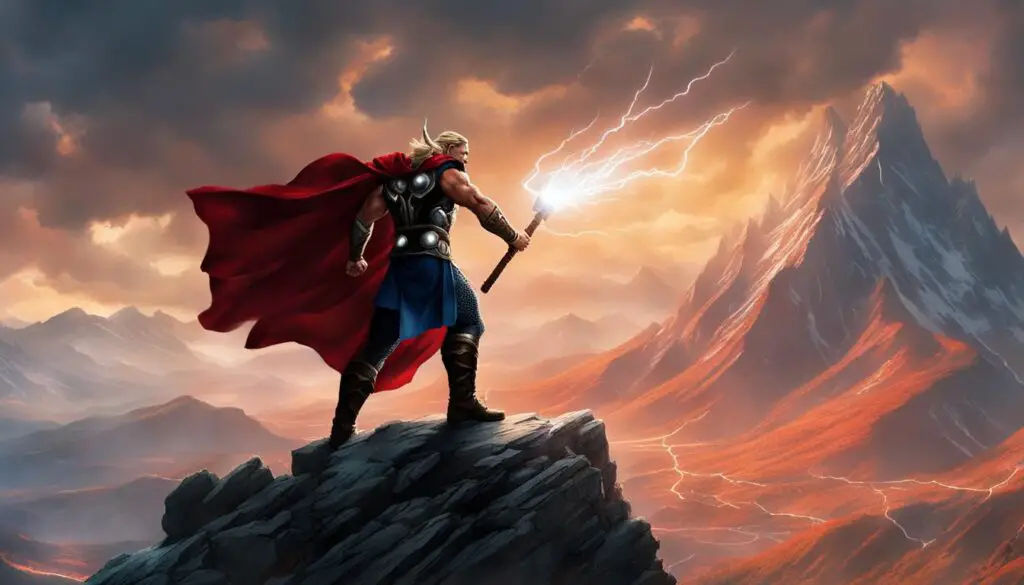
Thor, the god of thunder, is celebrated for his extraordinary physical strength and unwavering bravery in Norse mythology. He is renowned for his fearlessness and willingness to fight fiercely in battles, defending both the gods and the mortal world. Thor’s unmatched strength and unyielding courage contribute to his reputation as a mighty warrior.
Throughout Norse mythology, Thor’s immense power is depicted in various feats of valor. Whether facing formidable foes or challenging the forces of chaos, Thor never hesitates to confront danger head-on. His acts of bravery make him a revered figure among the gods and serve as an inspiration to mortals.
Thor’s strength is often portrayed as unrivaled, enabling him to accomplish extraordinary feats. He possesses the might to wield his hammer, Mjolnir, with effortless ease, striking down enemies and causing thunderous devastation. This godly strength is a testament to Thor’s divine lineage, as the son of Odin, the king of the gods.
In addition to his physical prowess, Thor’s bravery shines through in his unwavering determination to protect his fellow gods and the mortal realm. He fearlessly battles giants, monsters, and other forces of chaos to maintain the peace and order of the cosmos. Thor’s unwavering dedication to his duties and his innate sense of justice make him an emblem of valor and heroism.
Overall, Thor’s strength and bravery are defining characteristics that have solidified his position as a revered figure in Norse mythology. His indomitable spirit and unwavering courage serve as an inspiration to all who seek to embody the ideals of strength and bravery.
Thor’s Control Over Thunder, Lightning, and Storms
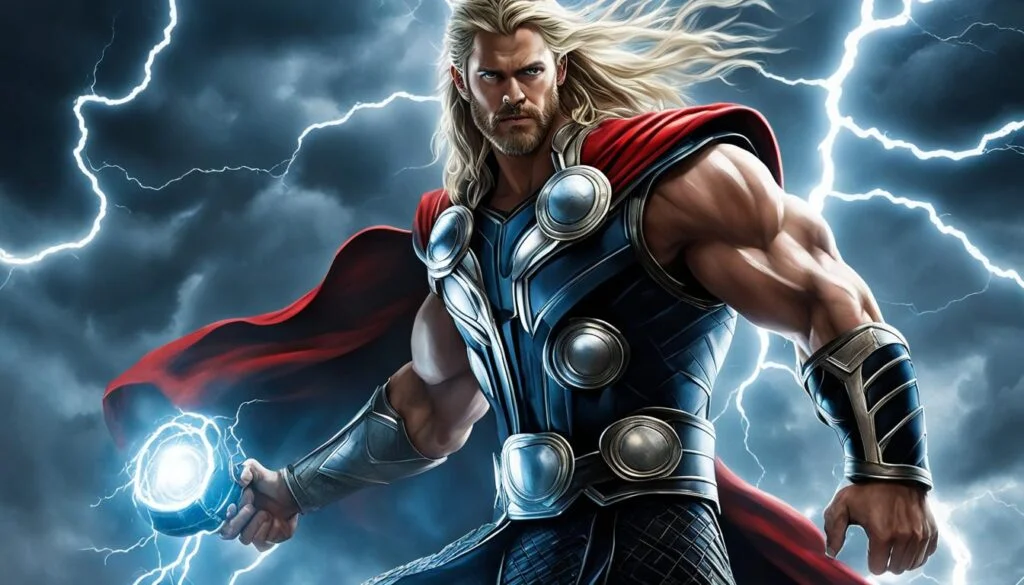
As the god of thunder, lightning, and storms, Thor possesses extraordinary power and dominion over these natural elements. In Norse mythology, he harnesses the might of thunderbolts and lightning by wielding his iconic hammer, Mjolnir. This ancient weapon enables Thor to summon thunderous storms and unleash bolts of lightning, showcasing his immense control over the forces of nature.
Thor’s ability to command thunder and lightning grants him immense power on the battlefield. With a single strike of Mjolnir, he can summon lightning bolts that rival the intensity of a raging tempest, devastating his enemies and asserting his authority as the god of thunder. These thunderous displays of power served as a testament to Thor’s strength and feared presence in Norse mythology.
To further reinforce his mastery over storms, Thor would unleash powerful whirlwinds and torrents of rain, his godly influence spreading across the land. These storms symbolized his raw power and the unpredictability of nature itself. Mortals and gods alike revered and feared Thor’s control over storms, recognizing him as the ultimate authority over weather and the skies.
Thor’s manipulation of thunder, lightning, and storms not only demonstrated his divine status but also highlighted his role as a protector. By controlling these natural phenomena, he ensured harmony in the realms of gods and mortals, shielding his kin and maintaining balance amidst the chaos of the cosmos.
Through the ages, Thor’s control over thunder, lightning, and storms has captivated the imaginations of mythologists and enthusiasts alike. His ability to harness these formidable forces serves as a reminder of the awe-inspiring power and influence attributed to the gods in Norse mythology.
The Role of Mjolnir in Thor’s Flight
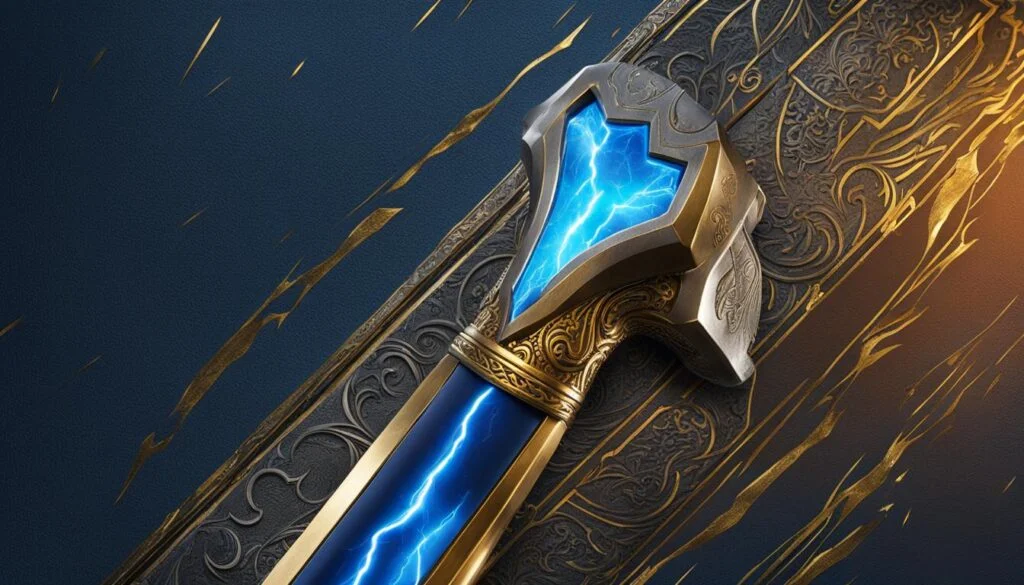
In the Marvel comics and movies, Thor is often depicted flying with the help of his hammer, Mjolnir. However, in Norse mythology, it is Thor’s chariot, drawn by two goats named Toothgnasher and Toothgrinder, that enables him to soar through the skies. Mjolnir, while a powerful weapon, does not grant Thor the ability to fly in the myths.
Despite Marvel’s adaptation showcasing Thor’s flight abilities with Mjolnir, the original Norse tales present an alternative method of transportation. Thor’s chariot symbolizes the power of the gods and provides him with the means to traverse the realms.
This fundamental difference highlights the divergent interpretations between myth and popular culture. While Mjolnir remains a crucial aspect of Thor’s character, it is essential to recognize the distinct storyline presented in Norse mythology.
To further visualize Thor’s chariot and his iconic hammer, take a look at the image below:
Thor’s Family and Lineage
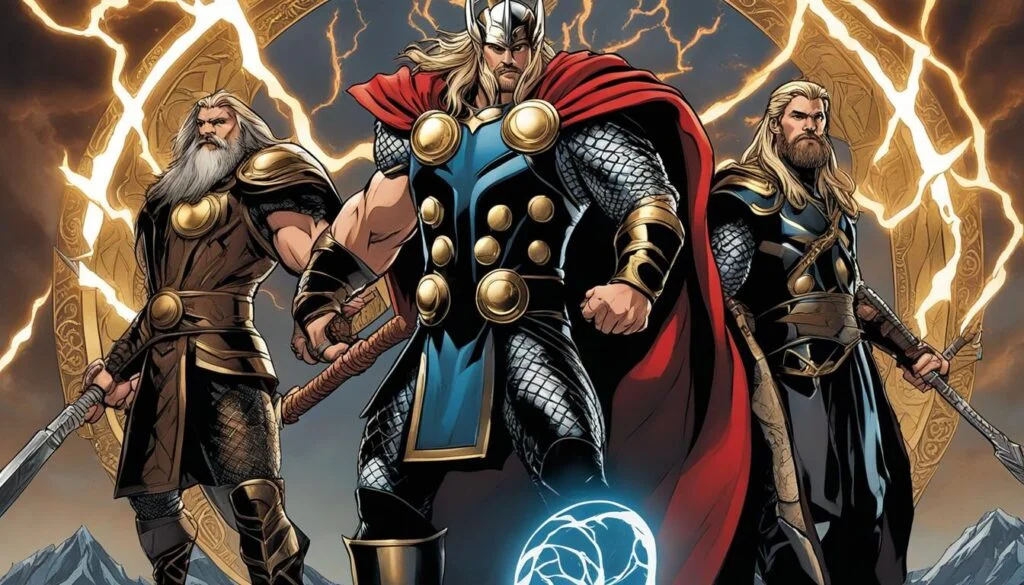
In Norse mythology, Thor’s family and lineage hold great significance. He is the son of Odin, the revered king of the gods, and Jord, the personification of the earth. Thor’s ancestry as a god of Asgard aligns him with the powerful pantheon of deities in Norse mythology.
Within his illustrious lineage, Thor has several notable family members. His wife, Sif, is a goddess known for her golden hair, representing the fertility of the earth. Together, they have a son named Magni, who inherits his father’s strength and will play a crucial role in the events of Ragnarok, the great battle foretold to bring about the end of the world.
Thor also has half-siblings from his father Odin. Baldr, the gentle and beloved god associated with light and purity, is one such sibling. Additionally, Vidar, known for his vengeance against the wolf Fenrir during the cataclysmic battle, and Hodr, associated with darkness and blindness, are part of Thor’s extended family.
Vali, another half-brother of Thor, is a god of justice and revenge. Born to Odin and the giantess Rindr, Vali’s birth served as retribution for the death of Baldr, with the infant Vali growing into a fully grown warrior in a single day to avenge his fallen brother.
Thor’s family and lineage highlight the interconnectedness of the gods of Asgard and their larger role in the Norse mythological tradition. Through their relationships and actions, the gods shape the fate of the cosmos and influence the events that unfold.
In Summary:
- Thor is the son of Odin, the king of the gods, and Jord, the personification of the earth.
- His wife, Sif, and son Magni feature prominently in Thor’s family.
- Baldr, Vidar, Hodr, and Vali are Thor’s half-siblings from Odin.
- Thor’s lineage connects him to the powerful gods of Asgard.
Thor’s Appearance in Norse Mythology
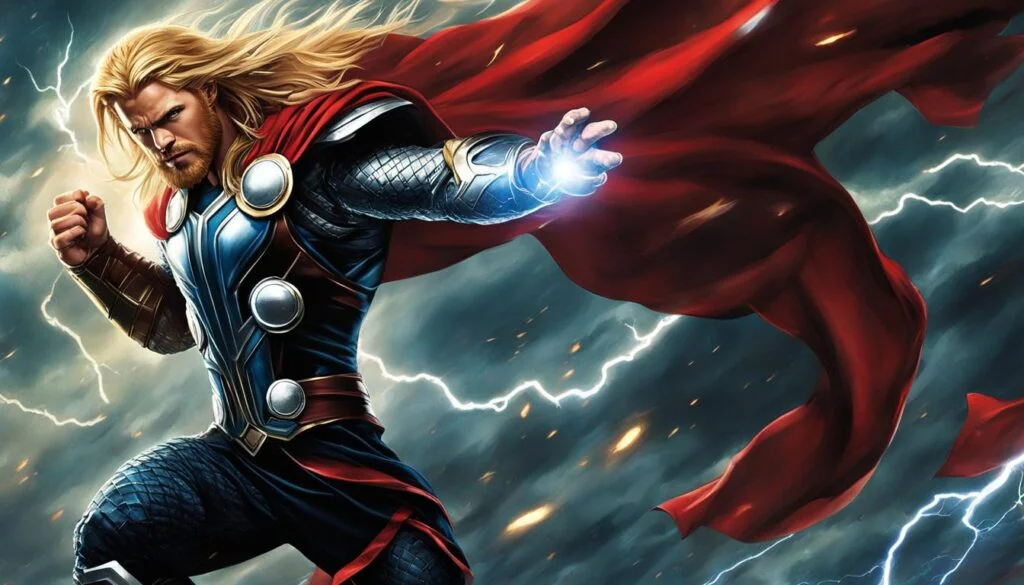
In Norse mythology, Thor is often depicted as a strong and muscular man with striking red hair and a fiery red beard. His powerful physique exemplifies his status as the god of thunder and lightning.
Thor’s iconic appearance includes his signature helmet, which he wears proudly as he wields his mighty hammer, Mjolnir. This helmet is adorned with intricate embellishments that signify his divine authority and immense power.
Additionally, Thor is frequently depicted wearing a belt and iron gloves. The belt, called Megingjord, enhances his already formidable strength, enabling him to perform remarkable feats. The iron gloves, named Járngreipr, allow him to firmly grasp and control his lightning-infused hammer.
The portrayal of Thor with red hair and a red beard in Norse mythology differs from the portrayal of a blond-haired Thor often seen in Marvel adaptations. This distinction showcases the diverse interpretations of the character across different media and highlights the unique characteristics attributed to Thor in the original Norse myths.
Thor’s Symbolism and Iconography
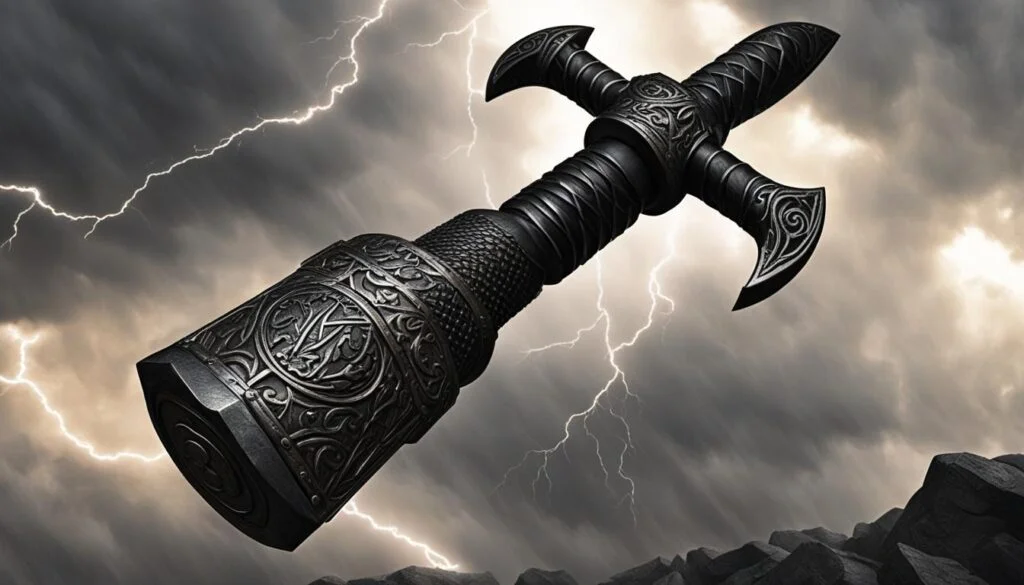
Thor, the god of thunder in Norse mythology, is associated with powerful and iconic symbols that represent his might and divine authority. The most recognizable symbol linked to Thor is his hammer, Mjolnir. This legendary weapon, crafted by the dwarves, is both a symbol of his power and a tool of destruction. Its intricate design and the sheer strength it represents make Mjolnir an enduring emblem of Thor’s prowess.
Furthermore, lightning and thunderbolts are often used as additional symbols of Thor’s dominion over thunderstorms. The crackling lightning bolts and booming thunder embody the raw energy and force wielded by Thor in his role as the god of thunder. These symbols serve as a reminder of Thor’s authority over the natural elements and his ability to call upon their might in battle.
The significance of these symbols extends beyond their representation of Thor’s power and strength. They also embody his role as a protector and defender. Thor uses Mjolnir and commands thunder and lightning to safeguard the gods and humans against the forces of chaos and evil.
Thor’s Place Among the Norse Gods
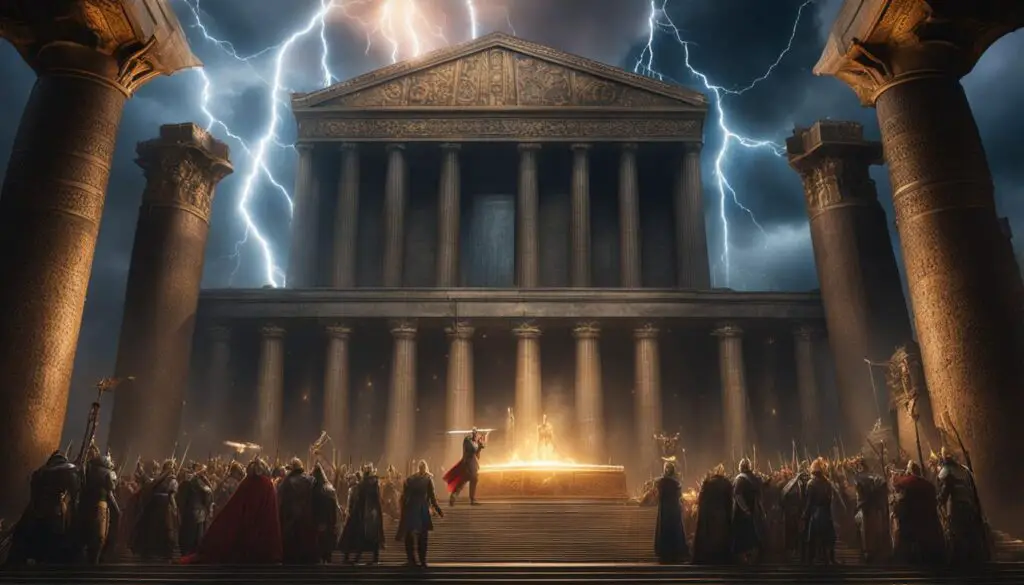
Within the Norse pantheon, Thor holds a significant position as a prominent member of the Aesir, the gods associated with power and war. He is revered for his strength, bravery, and role as a protector of both gods and mortals. Thor’s status among the gods is a testament to his might and influence.
Thor stands tall among the Norse gods, embodying the warrior spirit and representing the pinnacle of strength and courage. As a member of the Aesir, he is part of the divine pantheon that governs the realms of Asgard. Alongside other notable gods such as Odin, Freya, and Loki, Thor plays a vital role in the intricate fabric of Norse mythology.
With his hammer Mjolnir in hand, Thor defends the gods and their domains from threats, especially those posed by the giants and other supernatural beings. His unmatched physical prowess and unwavering bravery make him an invaluable ally and a formidable force on the battlefield.
As the god of thunder, Thor’s role extends beyond combat. Through his control of thunder and storms, he maintains order and balance in the natural world. His ability to summon thunderbolts and conjure lighting displays his authority over the forces of nature.
In addition to his responsibilities as a protector and a wielder of thunder, Thor also serves as a symbol of fertility, guarding both the gods and mortals against malevolent forces. His role as a god of power and war affirms his influence and establishes him as a vital figure within the Norse pantheon.
The Aesir: Gods of Power and War
- Thor’s membership in the Aesir showcases his affiliation with the deities associated with might and conflict.
- This group includes gods like Odin, the Allfather, and Tyr, the god of war and justice.
- Together, they uphold the cosmic order and protect the realms from chaos and destruction.
Thor’s Mythical Exploits and Tales

Thor, the legendary Norse god of thunder, is well-known for his daring adventures and heroic exploits. These captivating tales, deeply rooted in Norse mythology, offer a glimpse into the extraordinary character and mythical world of Thor.
One of Thor’s most famous escapades involves battling fearsome giants. In one tale, he faces off against the monstrous Thrym, who has stolen his beloved hammer, Mjolnir. With his unwavering determination and incredible strength, Thor embarks on a perilous journey to retrieve his powerful weapon and restore balance to the realms.
In another remarkable adventure, Thor encounters the formidable Jormungandr, a colossal sea serpent. The epic battle between the Thunder God and the mighty serpent rages across land and sea, demonstrating Thor’s unwavering bravery and his ability to confront even the most formidable adversaries.
Thor’s exploits also extend to his involvement in the retrieval of lost treasures. One such tale recounts his quest to reclaim the legendary cauldron called the Mead of Poetry. Thor faces numerous challenges and overcomes treacherous obstacles, showcasing his cunning and resourcefulness in the face of adversity.
These thrilling stories of Thor’s prowess and valor have been passed down through generations, captivating audiences with their blend of adventure, mythology, and larger-than-life heroism. Through these tales, we gain a deeper understanding of the cultural significance and enduring appeal of Norse mythology.
Conclusion
After exploring the world of Norse mythology, it becomes evident that flying is not among Thor’s powers. While Marvel’s adaptation often portrays Thor soaring through the skies with Mjolnir, the original Norse myths don’t attribute flight to the god of thunder. Instead, Thor’s incredible abilities lie in his immense physical strength, his control over thunder and storms, and his role as a protector.
In Norse mythology, Thor is renowned for his bravery and unwavering dedication to defending both the gods and the mortal world in battles. His dominion over thunder, lightning, and storms captures the awe-inspiring power he possesses.
The discrepancies between Marvel’s depiction and the original myths shed light on the evolution of Thor’s character in popular culture. While Marvel has incorporated certain elements from Norse mythology, such as Thor’s strength and control over thunder, it has also introduced creative liberties to fit the superhero narrative.
In conclusion, Thor’s abilities in Norse mythology are grounded in his physical prowess and control over thunder and storms, not in the power of flight. Through the ages, Thor has mesmerized audiences with his remarkable strength and the awe-inspiring mythology that surrounds him.
FAQ
Can Thor fly in Norse mythology?
No, flying abilities are not traditionally attributed to Thor in Norse mythology. Instead, he travels in a chariot drawn by two goats.
How is Thor depicted in Marvel compared to Norse Mythology?
Marvel’s adaptation of Thor includes alterations to his abilities, backstory, and appearance, merging the myths with the superhero world.
What are Thor’s strengths and bravery known for?
Thor is revered for his immense physical strength and unwavering bravery, making him a formidable warrior in battles.
What elements does Thor have control over in Norse Mythology?
Thor has the power to control thunder, lightning, and storms, showcasing his dominion over the forces of nature.
How does Mjolnir affect Thor’s flight?
In Norse mythology, Thor’s chariot, drawn by two goats, enables him to soar through the skies. Marvel’s adaptations often show Thor flying with the help of his hammer, Mjolnir.
Who are Thor’s family members in Norse Mythology?
Thor’s family includes his wife Sif, his children, and half-siblings such as Baldr, Vidar, Hodr, and Vali.
How is Thor’s appearance described in Norse Mythology?
Thor is typically depicted as a strong and muscular man with red hair and a red beard, often wearing a helmet and wielding Mjolnir.
What symbols are associated with Thor in Norse Mythology?
Thor is symbolized by his hammer, Mjolnir, which represents his power and strength. Thunderbolts and lightning are also used as symbols of his dominion over thunder and storms.
What is Thor’s role among the Norse gods?
Thor holds a significant position as a prominent member of the Aesir, the gods associated with power and war. He is revered as a protector of both gods and mortals.
What are Thor’s mythical exploits and tales in Norse mythology?
Thor embarks on numerous adventures, battling giants and retrieving lost treasures, showcasing his strength, wit, and determination.
Is flight attributed to Thor in Norse mythology?
No, the original Norse myths do not attribute flight to the god of thunder. Thor’s abilities in Norse mythology revolve around his immense physical strength, control over thunder and storms, and his role as a protector.


